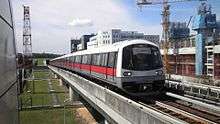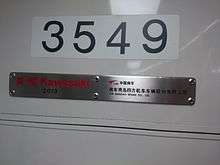Kawasaki Heavy Industries & CSR Qingdao Sifang C151A
| Kawasaki Heavy Industries & CRRC Qingdao Sifang (KSF) C151A | |
|---|---|
 A C151A train approaching Expo towards Tanah Merah. | |
| In service | 27 May 2011–present |
| Manufacturer |
Kawasaki Heavy Industries CRRC Qingdao Sifang |
| Built at | Qingdao, Shandong, China |
| Constructed | 2010–2014 |
| Entered service | 2011 |
| Number built | 210 vehicles (35 trainsets) |
| Formation |
6 per train set DT–M1–M2–M2–M1–DT |
| Fleet numbers | 501/502–569/570 |
| Capacity | 296 seated; 1,624 standing; 2 PIW spaces |
| Operator(s) | SMRT Trains (SMRT Corporation) |
| Depot(s) | Bishan, Changi, Tuas, Ulu Pandan and East Coast (future) |
| Line(s) served | East West Line, North South Line |
| Specifications | |
| Car body construction | Aluminium-alloy double-skinned construction |
| Car length | 23.5 m |
| Width | 3.2 m |
| Height | 3.7 m |
| Doors | 1450mm, 8 per car |
| Maximum speed |
90 km/h (56 mph) (design) 80 km/h (50 mph) (service) |
| Weight | 226.8t /335.9 t (laden) |
| Traction system |
IGBT-VVVF (Fuji Electric) Output 415 kVA x2 |
| Traction motors |
Self-Ventilated Three-Phase AC Induction Motor (Fuji Electric) 140 kW (190 hp) 550V 193A 1760 r/min |
| Power output | 2.24 MW (3,000 hp) |
| Transmission | WN Drive |
| Acceleration | 1.0 m/s2 |
| Deceleration |
1.2 m/s2 (service) 1.3 m/s2 (emergency) |
| Auxiliaries |
IGBT–VVVF Auxiliary Inverter with Battery Charger 80 kVA–16 kW |
| Electric system(s) | 750 V DC |
| Current collection method | Third rail |
| Braking system(s) | Regenerative Braking, Resistor Braking, Air Brakes |
| Safety system(s) |
Current: Westinghouse Brake and Signal Company Ltd fixed block ATC with subsystems of ATO GOA 2 (STO), ATP, ATS Thales SelTrac® Moving Block CBTC ATC with subsystems of ATO GOA 3 (DTO), ATP, NetTrac ATS, CBI |
| Track gauge | 1,435 mm (4 ft 8 1⁄2 in) standard gauge |
The Kawasaki Heavy Industries & CRRC Qingdao Sifang C151A, sometimes abbreviated to C151A or KSF C151A is the fourth generation Electric multiple unit rolling stock in operation on the North South and East West Lines of Singapore's Mass Rapid Transit (MRT) system. This additional batch of trains, together with a new track and platform at Jurong East Interchange, has increased the capacity of both lines by 15%.[1][2][3]
The initial contract of 22 trainsets of 6 cars each was awarded to Kawasaki Heavy Industries and CRRC Sifang by the Land Transport Authority. In 2013, a further order of 13 trainsets under Batch 2 was placed and as of 2014, all 35 trainsets have been officially put into revenue service.[4]
This is the last batch of rolling stock on the North South Line and East West Line to be painted in the original livery, including all Batch 2 trains even though they were made and painted in 2014.
On 5 July 2016, an investigative news report from FactWire alleged that C151A trainsets were being shipped back to Qingdao for rectification due to multiple defects, including an exploding battery and cracks on trains, but without notifying the public beforehand. The Singapore government acknowledged the trains were returned for rectification works, and have since published official statements to address FactWire's specific allegations.
History
On May 6, 2009, the Land Transport Authority announced that Kawasaki Heavy Industries and CSR Sifang had won over Hyundai Rotem, Bombardier Transportation and Mitsubishi Heavy Industries to secure the contract at a cost of S$369 million, despite Hyundai Rotem offering the lowest bid at S$323 million for the order of 22 trainsets under Batch 1. CSR Sifang handled the manufacturing and testing of the rolling stock, while Kawasaki oversaw the project and design. The C151A contract was the first successful joint venture between these two companies in the international market.[5]
Tender
The tender for trains under the contract turnkey 151A was closed in January 2009. The tender results were published in May 2009.[6]
| S/N | Name of tenderer | Amount ($S) |
|---|---|---|
| 1 | Bombardier (Singapore) Pte Ltd and Bombardier Transportation GmbH Consortium | 373,327,788.00 |
| 2 | Kawasaki Heavy Industries,/ Kawasaki Heavy Industries(Singapore) /CRRC Qingdao Sifang Locomotive and Rolling Stock | 368,997,888.00 |
| 3 | Mitsubishi Corporation | 393,301,698.52 |
| 4 | Hyundai Rotem | 322,729,548.00 |
Equipment
Main Propulsion Controller
The C151A trains is the third commuter type Electric Multiple Unit (EMU) made in Japan to feature electric systems fully manufactured by Fuji Electric. Propulsion is controlled by VVVF Inverter with 2-level IGBT semiconductor controller, rated at 415 kVA. Each inverter unit controls two motors on one bogie (1C2M), and one motor car features two of such units. Motors are three-phrase AC induction type, model MLR109, with a maximum output of 140 kW.
Bogies
The C151A trains uses the monolink axlebox type bolsterless air spring bogie. There are no major technical differences between a trailer and motor car bogie other than additional electrical components for the latter.
Auxiliary systems
A break from tradition, the C151A trains features auxiliary inverters for its electrical systems on all six cars of the train. Previously, auxiliary inverters were mounted only on motor cars. The VVVF Inverter is controlled by IGBT semiconductors and rated at 80 kVA. A battery charger is built with the inverter and provides 16 kW output.
Design
Exterior design

The C151A trains are similar to the C751B trains in terms of exterior looks, and have an identical propulsion motor sound. The only obvious difference comes from the front and doors of the C151A trains.
- C151A trains have bright yellow LED displays on the front and rear of the train, above the train operator's window, that are meant to show three-digit Train Run Numbers. C751B trains have orange LED displays,
- C151A trains have 'eye bags' on its headlights unlike C751B trains.
- The C151A trains front has a 'smiley face' curve design unlike the C751B trains, which has a straight design.
- The C151A's air-conditioner unit area is unpainted.
- The interior of a C151A has center grab poles that split into three; this is not a feature on C751B trains.
- The interior of a C751B has three thick black lines on the glass panes next to the reserved seats of every coach; this is not a feature on C151A trains.
- Next to every door, the C151A has a center blinking red LED light, while C751Bs have two, side blinking red LEDs.
Interior design
The C151A trains are similar to the C751B and the refurbished C151 trains in terms of interior looks.
- The wall of train is glossy white similar to the C751B trains.
- The floor, overhead panels and the placements of the door closing red LED signals are similar to the C151 trains, though the colour scheme is slightly different. The first and last cars have pink seats with the reserved seats in red (the C151 trains, though, have red seats with maroon reserved seats) while the rest of the cars are similar to the C151 trains in terms of the colour scheme of the seats (blue for the 2nd and 5th cars and green for the 3rd and 4th cars) albeit a slightly lighter shade.
- Notable difference of the C151A trains are the thicker grab poles, the curve dark grey aircon ventilator, the different stickers used to depict the fire extinguisher and the side panels with curvy designs on it.
- The train also comes with the STARIS embedded in the door's overhead panels. Since this is the only rolling stock which had STARiS since it left the factory while other rolling stock (excluding the C751A and C830) trains had STARiS installed some time after they commenced revenue service, this is also the first rolling stock in which the STARiS does not protrude out of the door panel and the last rolling stock to be fitted with STARiS Version 1.
Train Formation
The configuration of a C151A in revenue service is DT-M1-M2-M2-M1-DT
| Cars of C151A | ||||||||||
|---|---|---|---|---|---|---|---|---|---|---|
| car type | Driver Cab | Motor | Collector Shoe | car length | Wheelchair Space | |||||
| mm | ft in | |||||||||
| DT | ✓ | ✗ | ✓ | 23,830 | 78 ft 2.2 in | ✗ | ||||
| M1 | ✗ | ✓ | ✓ | 22,800 | 74 ft 9.6 in | ✗ | ||||
| M2 | ✗ | ✓ | ✓ | 22,800 | 74 ft 9.6 in | ✓ | ||||
The car numbers of the trains range from x501 to x570, where x depends on the carriage type. Individual cars are assigned a 4 digit serial number. A complete six-car trainset consists of an identical twin set of one driving trailer(DT) and two motor cars(M1 & M2) permanently coupled together. For example, set 555/556 consists of carriages 3555, 1555, 2555, 2556, 1556 and 3556.
- The first digit identifies the car number, where the first car has a 3, the second has a 1 & the third has a 2.
- The second digit is always a 5, part of the identification numbers
- The third digit and fourth digit are the train identification numbers. A full length train of 6 cars have 2 different identification numbers. For example 555/556 (normal coupling) or 555/570 (cross coupling).
- Kawasaki Heavy Industries & CSR Qingdao Sifang built sets 501-570.
Line Disruptions
After the 15 & 17 December disruptions, SMRT suspected that the extra weight from the train might have caused the disruptions. The C151As were temporarily suspended from running the full-day North South Line from January 2012 to November 2013. However, the Committee Of Inquiry (COI) report released to the public on July 4, 2012 concluded no evidence to suggest that 4th generation trains (the C151A trains) were responsible for the incident.[7]
After the suspension of service on 7 July 2015, which was the worst breakdown in SMRT history, SMRT engineers detected arcing problems on one of the C151As, but no evidence was shown that it was the root cause of the service suspension.
References
- ↑ "Extra metro trains for Singapore". Railway Gazette International. 2009-05-07.
- ↑ "Five new trains added to boost capacity of North-South and East-West Lines" (PDF). SMRT Corporation. 2011-05-16. Archived from the original (PDF) on 2011-09-27.
- ↑ "Train capacity to rise by up to 50% in 4 years".
- ↑ "Both orders for Singapore Subway Train 132 LTA". 29 August 2012. Retrieved 5 September 2012.
- ↑ "CSR Sifang and Kawasaki Heavy Industries Won the Bid in the Subway Vehicle Project of Singapore". May 13, 2009. Archived from the original on July 23, 2012. Retrieved February 8, 2012.
- ↑ "Tender Information". 2009-09-02. Archived from the original on September 2, 2009. Retrieved 2016-07-07.
- ↑ "REPORT OF THE COMMITTEE OF INQUIRY INTO THE DISRUPTION OF MRT TRAIN SERVICES ON 15 AND 17 DECEMBER 2011" (PDF). Ministry Of Transport. July 4, 2012. Retrieved July 4, 2012.
